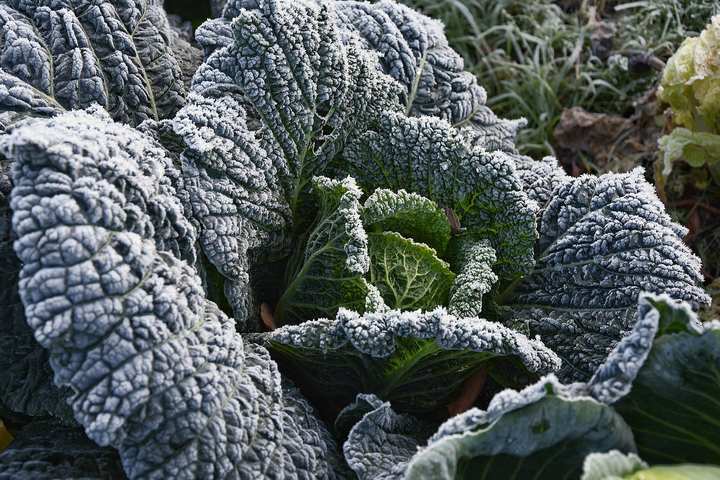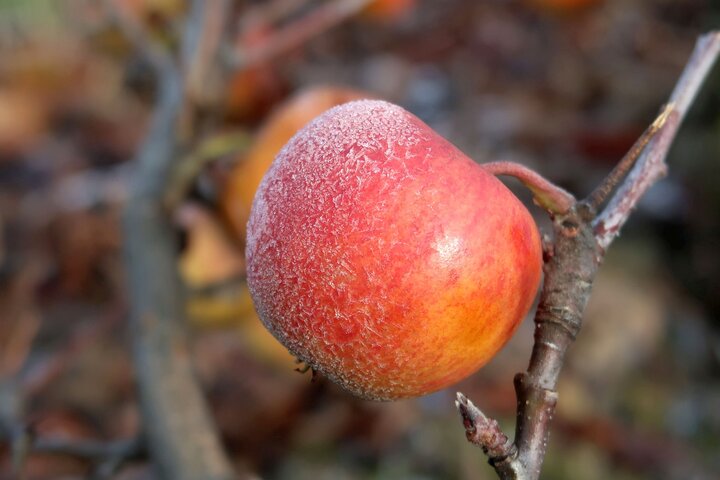Sarah Browning, Nebraska Extension Educator

Seeing frost on plants in the morning, like this rose, is an indication temperatures have gotten cold enough during the night to cause water to freeze. Image from Pixabay.com.
We've had our first touch of cold weather, with night temps falling to the upper 30s on October 6thand 7th, but no hard freezes yet. Of course, we're at the end of the gardening season. But if you have tender plants, and you want to keep them growing a while longer, it's important to pay attention to weather forecasts and provide protection if freezing temperatures threaten.
The average first fall frost for Lancaster County is about October 10th- actually between October 6thand 9thto be specific. These dates are determined from over 47 years of weather data, starting in 1949. It’s a good guideline to estimate when frost will occur, but since this is an average first fall frost date, half of all autumn freezes will occur before these dates and half will occur after.
What is Frost
Frost is the formation of small ice crystals on a surface, like leaves, petals or grass. To understand frost formation, you also need to understand dew point. The term “dew point” is the air temperature at which air is fully saturated with water vapor, so water is evaporating at the same rate as it is condensing.
When the temperature of a surface, like a leaf, falls below the current dew point of the air, water begins to condense on the leaf surface. Dew on grass and plant leaves is a common occurrence, but when the leaf surface temperature is also below freezing the water transitions directly to white ice crystals as it condenses on the leaf.

If the air is very dry, visible frost may not form even if air temperatures fall below freezing.
Understanding Freeze Damage in the Landscape
Seeing frost on plants in the morning is an indication temperatures have gotten cold enough during the night to cause water to freeze. The frost itself on plant surfaces is less damaging, but freezing of water inside the plant can cause significant damage. Think of what happens when pipes freeze in a house. Cell walls are ruptured as water between plant cells freezes.
The most important factors in plant damage are 1) how cold temperatures got, 2) how long did temperatures stay below freezing and 3) the cold tolerance of the plant. Low temperatures persisting for longer periods of time cause the most damage.
Preventing Frost Damage
Cold air from an advective freeze moves to the lowest areas of the landscape and "pools" there. This makes plants in low areas more susceptible to freeze damage than those in higher areas. When frost is forecast, concentrate your efforts on the warm-season plants or crops you want to save that will be injured by cold temperatures.
If you still have produce in the vegetable garden, consider the cold hardiness of these crops.
Very hardy
- Can withstand freezing temperatures and hard frost (less than 28° F) for short periods without injury.
- Asparagus, collards, endive, kale, kohlrabi, lettuce, mustard, pea, potato, rhubarb, rutabaga, salsify, spinach, turnip
Frost tolerant
- Can withstand light frosts (28 - 32° F) without injury.
- Beet, broccoli, Brussels sprout, cabbage, carrot, cauliflower, celeriac, celery, chard, Chinese cabbage, Jerusalem artichoke, onion, parsnip, radish
Tender
- Injury or killed by frost (28 - 32° F).
- Lima bean, beans (Lima & snap), cucumber, eggplant, muskmelon, okra, pepper, pumpkin, summer squash, sweet corn, tomato, winter squash, sweet potato, watermelon

At 22°F, apples freeze solid, cells break down and the fruit becomes soft. If only a few hours at this temperature occur, the fruit may still be usable, but they will not store well. Use them as soon as possible. After the freeze occurs, allow apples to remain on the tree until they have thawed. Frozen fruit bruise very easily and will be unusable.
Providing Frost Protection
A. Cover plants - Low-growing crops such as cucumbers and prostrate tomatoes are easy to cover with straw, newspapers or old bed sheets. Caged tomatoes and pepper and eggplant plants can be covered with paper grocery sacks or plastic trash bags.
The aim of covering plants is to trap heat from the soil in the air immediately around plants. It's important to uncover them the next morning, especially if you used plastic to fend off the frost. Plastic will trap the sun's heat the next day and plants may cook.
B. Finish your harvest before frost comes - Harvesting when frost threatens is another option. Whether you rush to pick your produce before frost depends largely on the crop, how you intend to use it and how soon you can use it if it does get frosted.
- Winter squash and pumpkins intended for storage should be harvested before frost because frost will damage their rinds and shorten their storage life. If they do get frosted, harvest them within a day or two and cook, freeze or can them immediately.
- Green tomatoes picked before frost can be stored at 50 to 55 degrees F and ripened for weeks. Those picked after frost will not ripen or keep long, however.
- Pepper plants turn black with frost and the fruits quickly turn mushy and rot. If you can't cover the plants, pick the peppers before frost.
- Though bean plants are killed by frost or a hard freeze, the pods do not show damage right away. Pick and use them as soon as possible.
- Summer squash plants wilt dramatically and fruits deteriorate quickly after freezing or frost. Pick summer squash before frost.
- The cole crops -- broccoli, cabbage, Chinese cabbage, cauliflower and Brussels sprouts -- will tolerate quite a bit of frost. Though a really hard freeze will reduce the keeping quality of even these hardy vegetables, it's not necessary to rush to cover or harvest them when frost threatens.
Images from Pixabay.com
- Cabbage can withstand light frosts (28 - 32° F) without injury.
- Because of their sugar content, apples don't start freezing until temperatures drop to 28-28.5 ° F.
Search Our Archive
Associated Video
Fall Color 2018
Nebraska Extension Landscape Horticulture Specialist Kim Todd takes us on a tour of the Backyard Farmer garden in late fall to see what's still blooming.